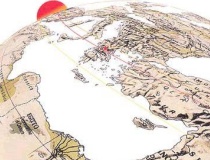For centuries, studious, philosophers, scientists and literates have been trying to trace the mythical continent of Atlantis in the geography, interpreting Plato and all Mediterranean legends which have done their own fulcrum in it, and for centuries each attempt is frustrated by absence of concrete demonstrations, as well as signs, testimonies, ideas...
Atlantis was a promised land situated beyond the Columns of Hercules. But where were those mythical columns 2000 years ago? Today, everybody put them in Gibilterra, but the analyses of the preceding texts, the new geography of Eratosthenes (the first one to destine them between Spain and Morocco), show that there was a lot of confusion to put the world limits when the Greeks doesn't make geography but the Phoenicians and the Carthaginians, who were heirs of those ancient lords of the sea of whom we lost the traces after a catastrophic event (Did Atlantis clamorously go down?).
The Mediterranean backdrops geology, to this intention, is so clear that also Sergio Frau, a journalist and archaeologist, has remarked that there is a precise zone which can be recognized as the border of the known world before commerce pushed more to West, the only one that possessed that insidious backdrops, and above all muddy and studded of shoals, that the ancients indicated as the Columns of Hercules: the channel of Sicily.
The Gibilterra Narrow has deep backdrops more than 300 meters and there has never been down mud over there, how could be in error the so many people who clearly described the narrow between Sicily and Tunisia?
 And if the Columns of Hercules were really wide of Sicily at the Plato's time, why would Atlantide have had to be at the Canaries or, least of all, at Sanotrini? And if the Columns of Hercules were really wide of Sicily at the Plato's time, why would Atlantide have had to be at the Canaries or, least of all, at Sanotrini?
But beyond those Columns, now replaced, there is an island which has an extraordinary climate (able to give more picked in a year), rich in metals and inhabited for long time by people, who built towers (the nuraghes of the Tirrenis) and which is perhaps closely related with the Etrurians, the Phoenicians and the Carthaginians. An island which could constitute a nearest natural coffer than the distant Spain which, who knows why, had to prefer the arriving of Lebanon and the Libya sailors. An island which must be secret and almost cancelled by the routs, a natural backup kind to darken in the night of the myth, an idea of a promised land whose name could be Atlantis. Sardinia is that island and several archeological inspections show that it has been suddenly a forsaken around 178-1175.
The nuragheses of the southern and western Sardinian coast, those at low quotas, are completely destroyed, headed, with big stones thrown on land, while those of northern Sardinia are today still standing: are earthquakes or seaquakes possible in an island considered for a long time quiet from a tectonic point of view? Geology could try to give a definitive answer by surveys opportunely situated in Campidano valley, near the nuraghes covered by an ooze, which seems a residue of an overflow or of a seaquake. If everything found further confirmations a lot of ideas must be changed: the history and the archaeology of the whole Mediterranean risk to be rewritten in a new vision of the ancient world, whose origin would be nearer than we can imagine. |

